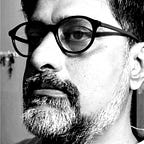A City in Slumber
Before COVID, we used to work from our Chennai office. It is a co-working space, in the Nungambakkam business district. Our office, in the 8th floor, overlooked the meandering Cooum river, one of the two major rivers that cuts through Chennai. The other one is River Adyar. A third waterway, built by the British for navigation, runs parallel to the East Coast, and dissects the two rivers perpendicularly.
Chennai is a city that has held to its intrinsic culture, while inviting foreign investments from the USA, Korea and Japan in particular, as it is known for its vibrant work culture and manufacturing prowess. For an outsider, the city would be known for its hot and humid climate, affable people and screaming posters of politicians dressed in white.
If one is to study Chennai’s history, Chennai was a confluence of these three waterways and a large marshland just to the South of the Adyar river. The original marshland extended till Pondicherry along the East coast road. The marshlands have since then been dried out, plotted and sold. Residential buildings and Industrial IT parks have mushroomed.
Cut back to 2019. I had been watching the river slowly flow by our office building, and the adjacent bridge in Chetpet, while sipping my green tea. The river is dark and shallow, carrying effluents from many sources. The river has been de-silted, so the water flows without any impediment.
In December 2015, the river carried a colossal volume of water, taking lives and property along its way, leaving behind a trail of destruction. The river has one of its origins in the Chembarambakkam lake, a lake which is dry most of the year, and gets filled during the North East monsoon ( between October and December). I had the privilege of living in the banks, but yet not be touched by the floods. I was part of a social media coordination team who ran relief and rescue in the neighborhood.
Cut back to 2019. There is no trace of the floods. Life carries on as normal. No tale is told about the events of December 2015, except when I talk to businesses who have fallen and risen, or that went bust because of the floods. The city seems to have forgotten the events otherwise.
The committees’ reports are a footnote in some Government order, and the funds allocated obviously have not been utilized. For a city that is in the coast region and have been identified as the one of the first few cities to be affected by rising sea levels due to climate change, the city seems to be content with its daily bickering.
I may sound cynical, but the reality is jarring. As I finished my cup of tea, I realize that the small discrete changes are happening on this front, invisible to the day to day lives, appears as things to note and act.
The city is a place of great intellect and enterprise. Private and voluntary efforts would not be sufficient. Honest acknowledgement by the Government and the political parties that the city is in the front line of climate change battle is the key starting point. Everything else must wait.
“Climate change is a human rights infringement — also it is a criminal offence, because by not taking action to fix it, a citizen would be essentially committing homicide of countless citizens of the future.”
― Abhijit Naskar, The Constitution of The United Peoples of Earth
~Ashok Subramanian
